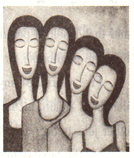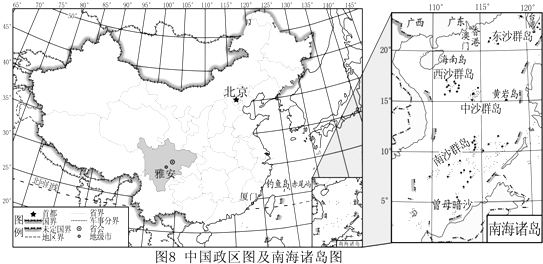题目内容
【题目】关于我国人口分布特点的叙述正确的 ( )
A. 高原多,平原少 B. 西北内陆多,东南沿海少
C. 少数民族地区人口多,汉族地区人口少 D. 东部地区多,西部地区少
【答案】D
【解析】中国人口地区分布不均。一般来说,以黑河-腾冲线为界,东部地区人口多(稠密),西部地区人口少(稀疏);沿海、沿河、沿湖地区人口多,干旱荒漠地区人口少;平原、盆地人口多,山地、高原人口少;经济和交通运输发达的地区人口多,经济落后、交通闭塞的地区人口少;城镇密集、工业发达的地区人口多,偏僻的农业、牧业地区人口少;汉族地区人口多,大部分少数民族地区人口少,故本题选D。

【题目】(题文)
We all know the strange feeling of watching the time change on a o’clock.
You never really see it change because the hands move so slowly. But, of course, the time is changing all the time.
Human faces, like clock faces, are also changing. And like clocks, the changes take place too slowly to be noticed. Over many thousands of years, though, huge changes are possible. For example, the human brain tripled (三倍的) in size. Our faces became flatter, and we began to think more.
If our heads became larger in the past, how will things change in the future? Unlike the changes of a clock face, the changes in human faces are not easy to predict (预测). It is mainly because of the way in which we can now control parts of nature. Hundreds of thousands of years ago, all changes were natural, but now we can actively choose paths for our own evolution(进化).
A US artist named Nickolay Lamm has recently offered an idea at what human faces may one day look like. The designs, inspired (受启发) by his conversations with scientist Alan Kwan, show humans with larger heads and eyes. In particular, Lamm predicts the forehead may be larger because of increasing usage of the brain.
Just a few hundred years ago, most humans were working in the fields, while nowadays more and more people get education. These are just predictions, and no one can be sure how human beings will evolve(进化) in the future. But with such huge changes in our environment, it seems likely that we will look very different one day.
Changes to human faces | |
Similarity between the changes to the(小题1) and ones to human faces | They both keep changing all the time. But these changes are too (小题2) to be noticed. Over the time, it is (小题3) for huge changes to take place. |
(小题4) of human faces changes in the past | The human (小题5) is three times as large as it was thousands of years ago. Human faces became flatter and humans began to think more. |
Possible changes in the (小题6) | It is hard to predict. One of the main(小题7) can be the way in which humans can control parts of the nature. A US(小题8), Lamn, shows humans with larger heads and eyes. Lamn predicts that because humans(小题9) the brain more often, the forehead may be larger. |
Conclusion | How human beings will evolve is (小题10) . But the huge changes in our environment are likely to make humans look very different. |


